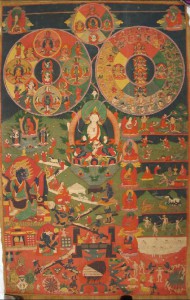While making dinner the other night, I received a difficult phone call that led me to think carefully about my work at the Rubin – particularly our recent exhibition, Bardo: Tibetan Art of the Afterlife. The woman who had been my surrogate grandmother had died. Elizabeth was 103. Her wake was going to start in two hours at a funeral home near my apartment.
Elizabeth had helped raise me when I was a boy, and she played a huge role in shaping me into the man I am today. Born in 1907 in Switzerland, her life suddenly felt to me like a great bridge stretching back in time beyond my ability to see. I sat very quietly for several minutes, listening to the sound of my husband working in the kitchen before letting him know that after dinner, we were going to a wake.
Elizabeth was Roman Catholic, and this was my first Catholic wake in a long time. She looked both small and strong in the open coffin. Her dress was navy blue, and her face was set in an inscrutable expression somewhere between peace and fortitude. The room was full of bright floral arrangements and a boisterous crowd of 50 or so were milling around the room chatting about her life. I got to shake her sons hands, and see her grandchildren for the first time in years. They were very kind to us, and made me feel welcome. One of her granddaughters talked to me for a while, and in her voice I could hear the tones and cadences that Elizabeth had used.
After an hour or so, a Roman Catholic priest gathered us together for a service. He was told us he was from the Philippines, and his accent was light and rhythmic. It reminded me of birdsong. He led us in a mass that lasted about twenty minutes, but changed the way I think about the importance of ritual.
I am culturally Episcopalian, and spiritually agnostic. Based on my upbringing, I knew about two-thirds of the prayers the priest led us in. But I had no idea what to do with my hands. The church I went to as a kid did not do a lot of self-crossing, and I was increasingly aware that I had no idea how to keep up with the crowds ritual motions. Afterward my husband (who is Jewish) turned to me and said, That was beautiful.
It really was. Death is overwhelming. I was still struggling to understand that I would never see Elizabeth again. I felt adrift. Mostly, I was trying to keep my composure. But her family had a system in place to help support them in the face of the unfathomable experience of death. Their ritual seemed to keep them rooted.
The art and sacred traditions of the Himalayas support different rituals. However, the Buddhist, Hindu, and other religious traditions represented in the Rubin Museum of Arts collection offer similar solace to people trying to wrap their heads around a world that is full of mystery, difficulty, and overwhelming realities like death. Art and ritual are closely entwined; if you spend time with this art, you may start to feel this. I wonder what a practitioner from the Himalayas would have thought of Elizabeth’s wake?



